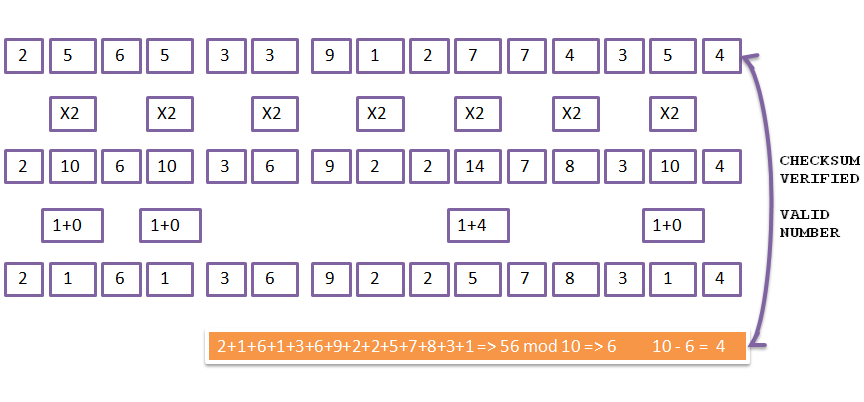

- #Credit card validator luhn algorithm javascript how to
- #Credit card validator luhn algorithm javascript code
numberString * 1 and parseInt(numberStr) do about the same.especially in an environment, where the microcode (instruction) can handle multiple bytes up to 256 or more in an (single CISC) instruction.
#Credit card validator luhn algorithm javascript code
Even for low-level language - such as assembler / machine code - the lookup table is the way to go. Iterating through the string and taking the unsigned 8-bit byte equal value to access the number of bits for that byte from the lookup table.

Each entry contains the number of bits set in an unsigned 8-bit integer equal to the index of the entry. )Ī perfect example of a nice lookup table application is the counting of set bits in bits lists - bits set in a a (very) long 8-bit byte string in (an interpreted) high-level language (where any bit operations are quite expensive). Var luhnFinalValue = (luhnIntermediateValue 0) Ĭorollar: Strings can be looked at as lookup tables of characters. Var luhnFinalValue = luhnArray // d is numeric value of digit to doubleĪn equal implementation for getting the luhnFinalValue looks like this: var luhnIntermediateValue = d * 2 // d is numeric value of digit to double Most implementations use the lookup array to avoid the cumbersome figuring out of the value for doubled digits: var luhnArr = The many answers in this thread go for different lookup tables and with that for different algorithms to implement the very same Luhn algorithm. Indication to use lookup tables are number oriented algorithms with simple arithmetics, simple comparisons, and equally structured repetition patterns - and of course - of quite finite value sets. On the other hand, understanding how the particular lookup array or data structure came to be can at times be quite difficult, because the related algorithm implementation may look - at first sight - quite different from the original algorithm specification or description. if the calculation of the lookup index is simple - or simpler - and the array's memory footprint is affordable. Lookup tables or arrays can simplify algorithm implementations - save many lines of code - and with that increase performance. Why are they using arrays? What is the significance of them, and how are they used to implement the algorithm as described by Wikipedia? The array they use seems to have no relation with Luhn algorithm, and I can't see how they achieve the steps described on Wikipedia.

Those implementations work very well, but I am confused about why they can use an array to do the work. However, I have also seen other implementations of the Luhn algorithm on Rosetta Code and elsewhere (archived). On Wikipedia, the description of the Luhn algorithm is very easily understood. Then the number is valid according to the Luhn formula else it is

Counting from the check digit, which is the rightmost, and moving.I read about the Luhn algorithm on Wikipedia:
#Credit card validator luhn algorithm javascript how to
The problem is I am not sure how to load the actual validation of the field within the form now.I am trying to implement simple validation of credit card numbers. It seems to properly load into the form as it shows up properly in the form in the frontend when I look at the source code. I have the JavaScript loaded into the form under Load JavaScript in the Setup Tab of the Form under the onLoad area as follows: I need to validate the entered number into a Credit Card field with the Luhn algorithm and javascript.


 0 kommentar(er)
0 kommentar(er)
